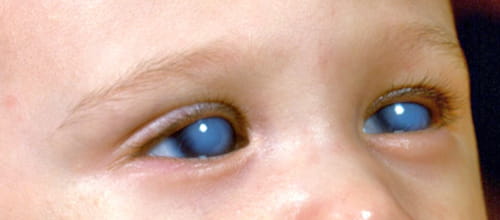‘UNITING FOR A GLAUCOMA-FREE WORLD’
PAEDIATRIC GLAUCOMA

Dr Nazia & Dr Ridham
Glaucoma is caused due to raised intraocular pressure (eye pressure) and changes in the optic nerve that help in sending visual messages to the brain for vision. Pediatric glaucoma can also present with these changes in eyes, but signs in the Pediatric age group may vary. Previously it was classified as Newborn onset glaucoma(age group 0-1 month), Infantile onset glaucoma (age group >1-24 months), and late-onset glaucoma (> 24 months). However, in 2013 International Classification of Childhood Glaucoma replaced all these classifications with a single term called primary congenital glaucoma.
Congenital glaucoma is a rare glaucoma that occurs in infants and young children, typically before the age of three. Primary congenital glaucoma occurs approx. 1 in 10,000 live births. In congenital glaucoma, there is usually a problem with the drainage system of the eye, which leads to increased intraocular pressure(eye pressure). Congenital glaucoma typically occurs by abnormal development of the eye’s drainage system during development inside the mother’s womb. In some cases, it may be associated with other congenital conditions or genetic abnormalities. The white part of the eye(sclera) is more distensible in children than adult eyes; owing to this difference, their eyes behave differently due to increased intraocular pressure. Diagnosis is usually made based on a thorough eye examination, which may include measuring intraocular pressure, evaluating the optic nerve, and examining the drainage angles of the eye. With early diagnosis and appropriate treatment, the prognosis for congenital glaucoma is generally favourable. However, if left untreated, congenital glaucoma can lead to permanent vision loss and blindness. Parents need to be aware of the signs and symptoms of congenital glaucoma and seek prompt medical attention if they suspect their child may be affected. Congenital and childhood glaucoma can have a good prognosis, provided they are treated timely and regular follow-up is done.
Symptoms
Childhood glaucoma usually presents with a triad of symptoms: epiphora (watery eyes), photophobia (sensitivity to bright light), and blepharospasm (squeezing of the eyes). Other symptoms that can be present in patients are enlargement of one or both eyes (buphthalmos), asymmetrical eyes, cloudiness or haziness of the cornea, and redness in the eyes. However, if the patient is having other problems with the eye or any system of the body then secondary childhood glaucoma can be present. Secondary glaucoma can be due to some other associated syndromes such as aniridia(complete or partial absence of the iris), microphthalmos(small eye), microcornea(small cornea), steroid-induced, trauma, tumors, glaucoma following cataract surgery, maternal rubella and some other systemic syndromes, etc. Since childhood glaucoma can have an irreversible impact on vision, it is advisable to prevent and treat these conditions early.
Prevention
There is no way to prevent primary congenital glaucoma, although childhood glaucoma secondary to trauma/ eye surgeries can be prevented to some extent. Prenatal genetic screening may emerge as a primary preventive measure for congenital glaucoma in the future. It is advisable to visit an eye doctor if parents notice anything unusual about their baby’s eyes. Any cloudiness in the eye, difference in the size of the eyeballs, or excessive tearing raises the suspicion of childhood glaucoma. In case of a positive family history of childhood glaucoma, all the siblings should be screened by an eye specialist.
Treatment
A specialized eye doctor will examine the eye, and intraocular pressure (eye pressure) may need to be recorded by handheld or portable machines (tonometers). In cases of further suspicion, the child may need to be examined under general anesthesia for complete diagnosis and management. Corneal examination (putli ki jaanch) along with recording of its diameter, examination of angles of the eye (gonioscopy), recording of intraocular pressure (eye pressure), measurement of axial length of eyeball, detailed fundus examination (recording of cup disc ratio) is possible under general anesthesia.
The treatment is decided based on the patient’s age, the extent of the disease, and overall health. In cases of congenital glaucoma, surgery is usually required. It is advisable to do surgery as early as possible. Surgery is done to establish the pathway for fluid drainage of the eye outside the blocked tissues, which, in turn, helps return the eye pressure to normal. Surgical options include goniotomy (incising the angle of the eye), trabeculotomy and trabeculectomy (removal of part of trabecular meshwork of eye). Some patients may require repeated surgery in case of failure. Some patients may require additional use of glaucoma drainage devices in case of failure of filtration surgery. Repeated eye examinations of the child may be required under general anesthesia after surgery. Medications used to treat glaucoma function by decreasing the production of eye fluid (aqueous humor) or increasing drainage. Usually, such medications (anti-glaucoma eye drops) are prescribed lifelong. Careful instillation of anti-glaucoma drops is advised to parents. Lifelong monitoring of eye pressure and routine complete examination of such children is recommended. Such patients may develop cataracts at an early age, which needs to be treated. In advanced cases cyclophotocoagulation may be required. In this procedure, freezing a part of the ciliary body is done, which is responsible for the production of aqueous (eye fluid), ultimately reducing eye pressure. Early diagnosis and intervention are crucial for preserving vision and preventing long-term complications in childhood glaucoma. Monitoring and regular follow-ups to assess the effectiveness of treatment and detect any progression of the condition.
(The writers are Assistant Professors, Department of Ophthalmology, AIIMS, Jammu).
